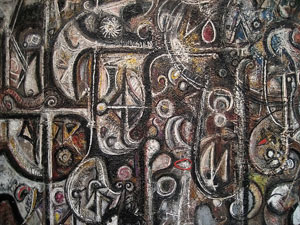Abstract expressionism
(Redirected from Abstract Expressionism)
Abstract expressionism is a post–World War II art movement in American painting, developed in New York City in the 1940s. It was the first specifically American movement to achieve international influence and put New York City at the center of the western art world, a role formerly filled by Paris.
Characteristics[edit | edit source]
Abstract expressionism is characterized by its emphasis on spontaneous, automatic, or subconscious creation. The movement's name is derived from the combination of the emotional intensity and self-denial of the German Expressionism with the anti-figurative aesthetic of the European abstract art schools such as Futurism, the Bauhaus, and Synthetic Cubism. Additionally, it has an image of being rebellious, anarchic, highly idiosyncratic, and, some feel, nihilistic.
Key Artists[edit | edit source]
Some of the most prominent artists associated with abstract expressionism include:
- Jackson Pollock
- Willem de Kooning
- Mark Rothko
- Franz Kline
- Robert Motherwell
- Clyfford Still
- Barnett Newman
- Ad Reinhardt
- Lee Krasner
- Joan Mitchell
Techniques[edit | edit source]
Abstract expressionist artists employed various techniques, including:
- Action painting: A style where paint is spontaneously dribbled, splashed, or smeared onto the canvas, rather than being carefully applied.
- Color field painting: Characterized by large fields of flat, solid color spread across or stained into the canvas creating areas of unbroken surface and a flat picture plane.
Influence and Legacy[edit | edit source]
The movement had a profound influence on both the American and international art scenes. It paved the way for later movements such as Pop Art, Minimalism, and Postmodernism. The legacy of abstract expressionism can be seen in the works of contemporary artists who continue to explore the boundaries of abstraction and expression.
Related Pages[edit | edit source]
Categories[edit | edit source]
Search WikiMD
Ad.Tired of being Overweight? Try W8MD's physician weight loss program.
Semaglutide (Ozempic / Wegovy and Tirzepatide (Mounjaro / Zepbound) available.
Advertise on WikiMD
|
WikiMD's Wellness Encyclopedia |
| Let Food Be Thy Medicine Medicine Thy Food - Hippocrates |
Translate this page: - East Asian
中文,
日本,
한국어,
South Asian
हिन्दी,
தமிழ்,
తెలుగు,
Urdu,
ಕನ್ನಡ,
Southeast Asian
Indonesian,
Vietnamese,
Thai,
မြန်မာဘာသာ,
বাংলা
European
español,
Deutsch,
français,
Greek,
português do Brasil,
polski,
română,
русский,
Nederlands,
norsk,
svenska,
suomi,
Italian
Middle Eastern & African
عربى,
Turkish,
Persian,
Hebrew,
Afrikaans,
isiZulu,
Kiswahili,
Other
Bulgarian,
Hungarian,
Czech,
Swedish,
മലയാളം,
मराठी,
ਪੰਜਾਬੀ,
ગુજરાતી,
Portuguese,
Ukrainian
Medical Disclaimer: WikiMD is not a substitute for professional medical advice. The information on WikiMD is provided as an information resource only, may be incorrect, outdated or misleading, and is not to be used or relied on for any diagnostic or treatment purposes. Please consult your health care provider before making any healthcare decisions or for guidance about a specific medical condition. WikiMD expressly disclaims responsibility, and shall have no liability, for any damages, loss, injury, or liability whatsoever suffered as a result of your reliance on the information contained in this site. By visiting this site you agree to the foregoing terms and conditions, which may from time to time be changed or supplemented by WikiMD. If you do not agree to the foregoing terms and conditions, you should not enter or use this site. See full disclaimer.
Credits:Most images are courtesy of Wikimedia commons, and templates, categories Wikipedia, licensed under CC BY SA or similar.
Contributors: Prab R. Tumpati, MD






